Table of contents
Due to their spicy aroma, which is best when used raw, shallots ( Allium cepa var. aggregatum) are very popular worldwide.
Use in the kitchen
What are shallots? What does a shallot look like? Shallots form an elongated to elliptical bulb, in contrast to the round bulb of the onion. They have a thin skin and can be of different colors (white, pink, yellow, red and gray). Shallots have a subtle, spicy-sweet taste and a fine consistency. Shallots should not be confused with Schlotten ( winter onions).
Can you eat shallots raw? Shallots taste best raw. Finely chopped, they go well raw in salads, dips, sauces, spreads, on bread or as a topping in soups. Is the shallot green edible? The younger leaves can also be used, similar to spring onions or chives.
They are less suitable for searing, as this can make them taste bitter and stale. It is best to add them to the dish shortly before the end of the cooking time. They go excellently with fried or steamed vegetables or in a rice pan. Shallots and red onions are popular for making chutneys and pickles. Caramelized and flavored with thyme or rosemary, shallots are a specialty. Shallots on vegan grilled skewers, tarte flambée, flans, focaccia or pizza give the dishes a subtle onion note.
Vegan recipe for pickled balsamic shallots
Ingredients (for 2 glasses approx. 10 dl): 750 g shallots, 1 dl white table wine, 1 tspblack pepper, 1 tsp yellow mustard seeds, 1 tsp salt, 3 dl balsamic vinegar (Aceto Balsamico), 2 tbsp brown sugar.
Preparation: Peel the shallots, halve the larger ones. Put the shallots, white wine, pepper, mustard seeds and salt in a pot. Bring to the boil and then simmer covered at a medium heat for approx. 15 minutes. Remove the shallots from the liquid and place in 2 clean preserving jars. Add the balsamic vinegar and brown sugar to the liquid and bring to the boil again. Pour the boiling liquid over the shallots and seal the jars immediately. Allow the jars to cool on a cloth.
Vegan recipes with shallots (raw) can be found under the note: " Recipes that have the most of this ingredient ".
| Not only vegans or vegetarians should read this: Vegans often eat unhealthily. Avoidable nutritional errors. |
Purchasing - Storage
Shallots are available at most major retailers such as Coop, Migros, Denner, Volg, Spar, Aldi, Lidl, Rewe, Edeka, Hofer and Billa, some of them also in organic quality. Shallots can also be bought in organic supermarkets such as Denn's Biomarkt and Alnatura. Shallots are available all year round due to stock and import goods.
The availability of shallots (raw) varies depending on the size of the store, catchment area, etc. Our recorded food prices for the DA-CH countries can be found above under the ingredient image - and by clicking on them you can see their development at various suppliers.
Found in the wild
Direct, wild-growing ancestors of the Allium species do not exist, or are not known. Wild relatives are alliums such as wild garlic ( Allium ursinum), chives ( Allium schoenoprasum), cabbage leek or vegetable leek ( Allium oleraceum), conspicuous or strange leek ( Allium paradoxum) and others. 2
Storage tips
Ripe shallots with dry skin should be stored in a dry, dark place or in a container (not hermetically sealed). If the shallot is cut, it should be stored in a container (eg a cheese cover) in the refrigerator, because other foods and packaging can absorb the smell. The taste of the cut shallot also loses quality, which is why it is best to always use it fresh.
Ingredients - Nutritional values - Calories
100 g of raw shallots (organic) have an energy content of 72 kcal. They consist of 80% water and contain 17 g of carbohydrates, 3.2 grams of fiber and a small amount of protein and fat per 100 g. 1
Raw shallots contain 0.34 mg of vitamin B6 (pyridoxine). This corresponds to 25% of the daily requirement. Jackfruit and durian have a similar value. In comparison, garlic contains much more of this vitamin at 1.2 mg/100g. 1
The folate (folic acid) content is not very high at 34 µg/100g, considering the daily requirement of 300 µg. Beefsteak tomatoes and celery have similar values. In contrast, kale has a higher content at 141 µg/100g and romaine lettuce at 136 µg/100g. 1
Shallots also contain potassium (334 mg/100g corresponds to 17% of the daily requirement), similar to wild garlic orbroccoli. Garden cress has almost twice as much (606 mg/100g) - dried onions have even more potassium (1622 mg/100 g). 1
The complete ingredients of shallots (raw), the coverage of the daily requirement and comparison values with other ingredients can be found in our nutrient tables. In the article Nutrients explained you will get a detailed insight into the topic.
Health Effects
Are shallots healthy? Shallots have anti-inflammatory and antioxidant properties. They are rich in phytochemicals such as phenolic compounds and flavonoids. There is increasing evidence that vegetables and fruits have chemopreventive properties thanks to their secondary plant substances. This means that they can help prevent or delay the onset of diseases such as cancer. 12 Thanks to their antioxidant properties, shallots help reduce oxidative cell stress. This is harmful and is partly responsible for the development of various non-communicable diseases such as cardiovascular diseases, cancer, diabetes and chronic lung diseases. The antioxidant properties can also be detected in cooked shallots. 13
In vitro studies show that shallots and shallot extracts have antibacterial, antifungal and antiviral effects. 13
Dangers - Intolerances - Side effects
Although most onions are poisonous or indigestible for humans, kitchen onions even help to maintain our health. However, they can be poisonous for other mammals. Some allergy sufferers can develop contact eczema, in which - as with garlic - low-molecular sulphur compounds act as allergens. Onions contain other proteins that can trigger allergies: lipid transfer protein (All c 3), profilin (All c 4, cross-allergen with grass pollen), alliin lyase (cross-allergen with other types of allium). 3
Shallots contain fructans as a reserve substance. Eating shallots raw or cooked can have undesirable effects (side effects), such as bloating or flatulence. The human digestive system cannot break down the fructans enzymatically and does not absorb them in the small intestine. In the large intestine, the bacteria metabolize them and produce gas. 4
Danger of confusion
There is certainly a danger of confusion with flower bulbs. The bulbs of daffodils or tulips look very similar to shallots and onions. Eating flower bulbs can cause vomiting, diarrhea, drowsiness, dizziness, collapse and paralysis. 14 Very high doses can even lead to death.
Folk medicine - natural healing
Shallots can be used in a similar way to onions as a traditional home remedy for respiratory diseases and colds. You can find out more about this under the ingredient onion.
Ecological footprint - animal welfare
When studying the ecological balance, no distinction is often made between the individual types of onion.
In 2019, the Institute for Energy and Environmental Research Heidelberg ( ifeu) examined almost 200 foods in Germany for their environmental impact. The calculation of the ecological footprint is based on average values for agricultural production (including all upstream processes, such as fertilizer production), food processing, packaging (including disposal of the same) and distribution to the supermarket. Different cultivation methods (organic - conventional), domestic production vs. import by truck, ship or plane, etc. were also taken into account. For selected foods, the authors also point out the phosphate, water and land consumption. A CO 2 footprint of 0.2 kg CO 2 eq/kg is known for onions. 5
Another positive aspect for the environmental balance is the possibility of outdoor cultivation almost all year round in the DA-CH region if suitable varieties are chosen. 7 The amount of water required to produce 1 kg of onions is on average 272 litres. 6
Onions can contain residues of pesticides. 8 Ideally, you should buy onions that have been grown organically, as the use of such pesticides is prohibited.
Worldwide occurrence - cultivation
Shallots ( Allium cepa var. aggregatum) belong to the plant species of the edible onion ( Allium cepa). The onion is one of the oldest cultivated plants. It has been used as a medicinal plant, spice and vegetable for more than 5000 years. Since the wild ancestors are unknown, the geographical origin is also not clear. According to pharmacist M. Pahlow, the onion comes from western Asia and the Romans brought it to Central Europe. 11
According to FAOSTAT, 106.59 million tons of onions and shallots were produced worldwide in 2021. The main producing countries are India (26.64 million tons), the People's Republic of China (24.16 million tons) and Egypt (3.31 million tons). By comparison, Germany produced 738,540 tons in 2021, Austria 168,660 tons and Switzerland 49,000 tons. 10
Cultivation - Harvest
Shallots prefer a sunny location with the most sandy soil possible. It is important that the soil is not too heavy or compacted, as waterlogging can lead to rot. Shallots are planted in spring from March and harvested from August. A depth of around 5 cm is recommended. The shallots must be planted in the direction of growth, i.e. with the fine roots facing downwards. There should be a distance of 15 to 20 cm between the individual bulbs in the row. 9
Further information
Shallots belong to the genus Leek ( Allium). For a long time they were a separate plant species ( Allium ascalonicum L.). Today they are seen as a subspecies of the onion and are identified as Allium cepa var. aggregatum. 9
In addition to the red shallots ( Allium cepa var. aggregatum), there are also the Persian shallot ( Allium stipitatum) and the grey shallot ( Allium oschaninii).
Alternative names
Alternative names are noble onion, ascalon onion, eshalotte, ash shallot or eshalotte. Shallot varieties are Jersey shallot, grey shallot and yellow shallot (shallot of Holland). Incorrect spellings are "Scharlotten" and "Charlotten".
The English name for shallots is shallots.
Bibliography - 14 Sources (Link to the evidence)
| 1. | USDA United States Department of Agriculture. |
| 2. | Fleischhauer SG, Guthmann J; Spiegelberger R. Enzyklopädie. Essbare Wildpflanzen. 2000 Pflanzen Mitteleuropas. 1. Auflage. AT Verlag: Aarau. 2013. |
| 3. | Enrique E, Malek T, Mateo J, et al. Involvement of lipid transfer protein in onion allergy. Annals of Allergy, Asthma & Immunology. 2007;98(2):202. doi:10.1016/S1081-1206(10)60700-4. |
| 4. | Muir JG, Shepherd SJ, Rosella O, Rose R, Barrett JS, Gibson PR. Fructan and free fructose content of common Australian vegetables and fruit. J Agric Food Chem. 2007 Aug 8;55(16):6619-27. |
| 5. | Reinhardt G, Gärtner S, Wagner T. Ökologische Fussabdrücke von Lebensmitteln und Gerichten in Deutschland. Institut für Energie- und Umweltforschung Heidelberg. 2020. |
| 6. | Mekonnen MM, Hoekstra AY. The green, blue and grey water footprint of crops and derived crop products. Hydrol. Earth Syst. Sci. 2011; 15: 1577-1600. |
| 7. | Bundessortenamt. Beschreibende Sortenliste. Wurzelgemüse, Zwiebelgemüse, Kohlgemüse, Hülsenfrüchte. 2001 (PDF). |
| 8. | Niedersächsisches Landesamt für Verbraucherschutz und Lebensmittelübersicht. Rückstände von Pflanzenschutzmitteln in Zwiebeln? |
| 9. | Plantura.garden. Schalotte: Die kleine Schwester der Küchenzwiebel. |
| 10. | FAOSTAT Food and Agriculture Organization of the United Nations. Onions and shallots, dry (exluding dehydrated). Production Quantity. 2021. |
| 11. | Pahlow M. Das grosse Buch der Heilpflanzen. Nikol Verlag. 2013. |
| 12. | Mohammadi-Motlagh HR, Mostafaie A, Mansouri K. Anticancer and anti-inflammatory activities of shallot (Allium ascalonicum) extract. Arch Med Sci. 2011 Feb;7(1):38-44. |
| 13. | Moldovan C, Frumuzachi O, Babotă M, Barros L, Mocan A, Carradori S, Crişan G. Therapeutic Uses and Pharmacological Properties of Shallot (Allium ascalonicum): A Systematic Review. Front Nutr. 2022 Jul 28;9:903686. |
| 14. | Hussein A, Yassin A. Poisoning following ingestion of Narcissus Tazetta Bulbs by schoolchildren. |

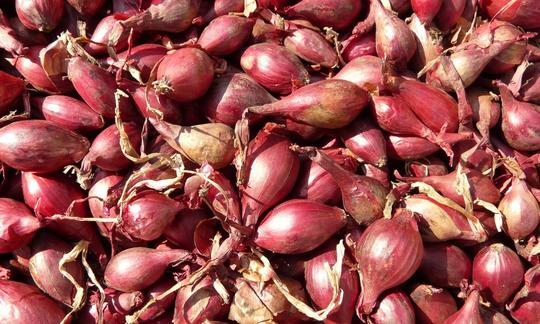

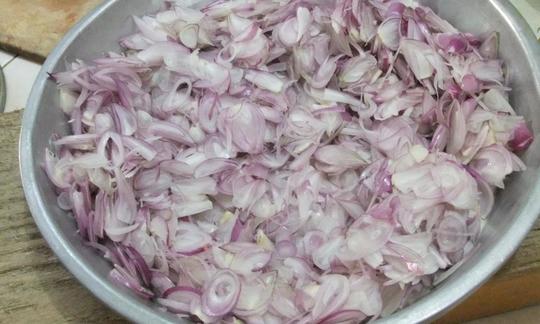

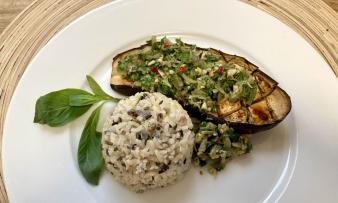
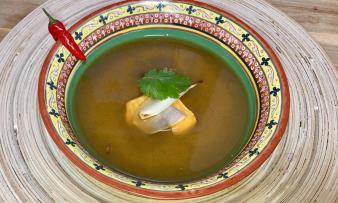
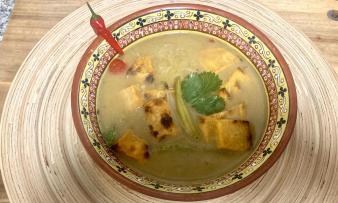





Comments